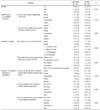Abstract
Objectives
The purpose of this study was to evaluate the effect of nutrition education using materials based on social cognitive theory. Education topics focused on improving health-related and dietary self-awareness and behavior capability in adolescents.
Methods
Participants were recruited from a middle school for girls; 67 students (educated group, n=34 and control group, n=33) participated. The education group received 12 lessons in club activity class. Self-administered surveys were conducted for each group before and after the nutrition education program. The questionnaires consisted of variables such as self-efficacy, outcome expectation, outcome expectancy, knowledge, and dietary practices based on the social cognitive theory. Education satisfaction was evaluated using a five-point Likert scale for two sections: a) teaching and learning and b) education results. The data were analyzed using a t-test and Chi Square-test (significance level: p < 0.05).
Results
In the education group, post-education, there were significant differences in self-efficacy (p < 0.05), knowledge (p < 0.01), and dietary practices (p < 0.05), whereas outcome expectation and expectancy did not show any significant differences. None of the variables showed any significant differences in the control group. Educational satisfaction scores were 4.38 ± 0.12 (teaching and learning) and 4.14 ± 0.15 (education results).
Figures and Tables
Table 5
Comparison nutrition knowledge between groups

1) P1: paired t-test between Pre-test and Post-test
2) PΔ: paired t-test for changes in parameters between educated group and control group
3) Mean±SE, Total score: 22 (0=wrong answer, 1=right answer; food choice score-10; intake control score-5; meal plan score-3; meal preparation score-4)
4) NS: No significance
Acknowledgments
This research was supported by a grant from the Ministry of Food and Drug Safety (14162MFDS130).
References
1. Lee KH, Kim GW, Lee YK, Lee SM, Son SM. Nutrition education and counselling. 3rd ed. Seoul: Life Science Publishing Co.;2015. p. 22. p. 27. p. 275. p. 353.
2. Ministry of Health and Welfare & Korea Centers for Disease Control and Prevention. Korea National Health and Nutrition Examinatio n Survey (KNHANES VI-2) [Internet]. Korea Health Statistics;2015. [cited 2016 Nov 9]. Available from: http://knhanes.cdc.go.kr.
3. Korea Centers for Disease Control and Prevention. The 11th Korea Youth Risk Behavior Web-based Survey. 2015. [cited 2016 Nov 9]. Available from: http://yhs.cdc.go.kr.
4. Han MR, Lim JH, Song YJ. The effect of high-carbohydrate diet and low-fat diet for the risk factors of metabolic syndrome in Korean adolescents: Using the Korean National Health and Nutrition Examination Surveys (KNHANES) 1998-2009. J Nutr Health. 2014; 47(3):186–192.
5. Lee YA, Shin CH, Lim JS. Measures against pediatric metabolic syndrome. J Korean Med Assoc. 2010; 53(5):392–406.
6. Moon SM. Educational psychology. Paju: Yangseowon;2014. p. 161–166.
7. Han SY. A study of relationship among physical symptoms, mental health according to stress factors of middle school students. J Korea Acad Ind Coop Soc. 2012; 13(12):5800–5807.
8. Jeong IG, Nam GO, Kim JH. The effects of academic stress on dietary behavior in junior high school students. Korean Educ Inq. 2012; 30(3):125–143.
9. Truswell AS, Darnton-Hill I. Food habits of adolescents. Nutr Rev. 1981; 39(2):73–88.
10. Ministry of Gender Equality & Family. Development of action plans for improving adolescents' health. 2012. [cited 2015 Feb 9]. Available from: http://www.mogef.go.kr/korea/view/policy/policy02_01g.jsp?func=view&idx=642924.
11. Kang YH, Yang IS, Kim HY, Lee HY. Identifying the subjects of nutrition education for junior and senior high school students. Korean J Nutr. 2004; 37(10):938–945.
12. Lee KH, Lee KA, Lee SM, Woo TJ. Evaluation of dietary education's effect on dietary awareness and practices in adolescents. Ministry of Food and Drug Safety Research report. 2014. Report No. 14162MFDS130.
13. Son SM, Lee KH, Kim KW, Lee YK. Nutrition education and counselling. . Seoul: Life Science Publishing Co.;2009. p. 49–50.
14. Dewar DL, Lubans DR, Plotnikoff RC, Morgan PJ. Development and evaluation of social cognitive measures related to adolescent dietary behaviors. Int J Behav Nutr Phys Act. 2012; 9:36.
15. Woo T, Lee KH. Effects of sensory education based on classroom activities for lower grade school children. Nutr Res Pract. 2013; 7(4):336–341.
16. Contento IR. Nutrition education linking research, theory, and practice. 3rd ed. MA: Jones & Bartlett Learning;2015. p. 13p. 138–139. p. 177–179. p. 310–331.
17. Lee JS, Yun JW. A study on perception about body image, dietary attitude, dietary self-efficacy and nutrient intake of high school students in Busan. J Korean Soc Food Sci Nutr. 2003; 32(2):295–301.
18. Suh Y, Chung Y. Comparison of mineral and vitamin intakes according to the stage of change in fruit and vegetable intake for elementary school students in Chungnam province. Korean J Nutr. 2008; 41(7):658–666.
19. Granner ML, Evans AE. Measurement properties of psychosocial and environmental measures associated with fruit and vegetable intake among middle school adolescents. J Nutr Educ Behav. 2012; 44(1):2–11.
20. Woo TJ, Lee HJ, Lee KA, Lee SM, Lee KH. Gender differences in adolescents' dietary perceptions and practices. Korean J Community Nutr. 2016; 21(2):165–177.
21. Yu NH, Kim MJ, Han JS. A study on the food intake frequency, dietary habits and nutrition knowledge of middle school students who like sweets in Busan. J Korean Soc Food Sci Nutr. 2007; 36(6):735–744.
22. Kim JS, Kim YN. Body perception, dietary attitude and selfesteem in middle school boys and girls. J Korean Home Econ Educ Assoc. 2009; 21(2):123–139.
23. Molaison EF, Connell CL, Stuff JE, Yadrick MK, Bogle M. Influences on fruit and vegetable consumption by low-income black American adolescents. J Nutr Educ Behav. 2005; 37(5):246–251.
24. Kwon MS, Cho HR, Park DJ. A comparison between Seoul and Gangwon-do in elementary students' eating habits and their mothers' parenting attitude toward eating habits. Korean J Health Educ Promot. 2013; 30(5):101–112.




 PDF
PDF ePub
ePub Citation
Citation Print
Print









 XML Download
XML Download